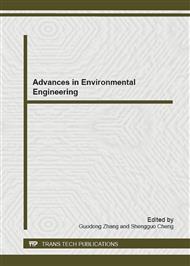p.412
p.418
p.428
p.434
p.441
p.448
p.455
p.462
p.467
Purification Effects of Artificial Vegetated Floating Bed on Polluted Water
Abstract:
Four species of ornamental plants, namely Thalia dealbata Fraser ex Roscae, Hydrocotyle vulgaris L., Iris pseudacorus L. and Canna indica L. were planted on the ecological floating bed, respectively, so as to study their effects of removing pollutants from polluted water. The experiment lasted for 42 days. The results indicate that the four plant species are adaptable to grow in polluted water and their fresh weights, heights and roots increased significantly at the end of the experiment. The growth rates are in the sequence of Canna > Thalia dealbata > Iris > Hydrocotyle vulgaris. The four test plant species have different effects on DO concentration in water, and the influence degrees are in the sequence of Hydrocotyle vulgaris > Thalia dealbata > Canna > Iris. All of the four plant species have a strong ability to remove NH4+-N, TN, TP and CODcr,, which is higher than that of the control treatments (P<0.05). The efficiencies of removing NH4+-N TN, TP and CODcr, by Hydrocotyle vulgaris , Thalia dealbata , Canna and Iris are 96.83%, 90.32%, 82.75% and 78.73%; 78.98%, 76.15%, 70.87% and 62.43%; 62.28%, 56.57%, 60.00% and 54.84%; 93.99%, 92.96%, 92.45% and 92.39%, respectively. Seeing that they have significant removal efficiencies on pollutants, the four plant species are recommended as ornamental plants applicable to ecological restoration engineering of polluted water in urban areas.
Info:
Periodical:
Pages:
441-447
Citation:
Online since:
November 2012
Authors:
Price:
Сopyright:
© 2012 Trans Tech Publications Ltd. All Rights Reserved
Share:
Citation:


